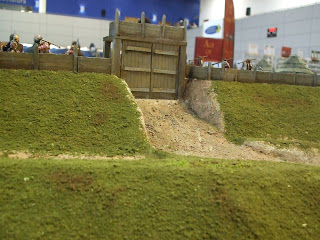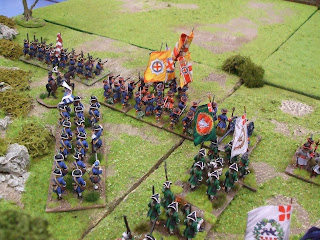I came across a report on the battle of Schottenheim on the
Napoleonic Warfare blog . This covers imaginary campaigns in Europe using 6mm figures. Large units are used and the photos give a great sense of masses of men on the move.
The outline of the scenario is that Marshal Ney is attempting to prevent Marshal Blucher from attacking an isolated force besieging an important town. He is moving from west to east across the map via the bridge over the Graunwasser near Neukirk before passing through Schottenheim. Not expecting any problems he halted his forces near Neukirk last night. Yorck (7 battalions) and Kleist (8 battalions) are east of the river, whilst Roder (5 regiments of cavalry) and Alvensleben (4 battalions of grenadiers) are on the west bank. Hardegg's Austrians (7 battalions) arrive at dawn to join the advance; but dawn also reveals that Ney has marched through the night and the leading elements of his force, the infantry divisions of Stockmayer (8 battalions), Fontanelli (8 battalions) and Maison (10 battalions) are now abreast of the Schottenheim road, barring Blucher's progress. Never one to shirk a challenge, Blucher orders his men forward, Yorck, Kleist and Hardegg are to pin Ney's men in position whilst Roder and Alvensleben advance north and then cross the Graunwasser by a second bridge and fall on the flank of their opponents.

Marshal Ney is not one to hold back either. Unknown to Blucher Ney has Legrand's division (6 battalions) and Chastel's cavalry (4 under-strength cavalry regiments) marching towards the battlefield from the north. Therefore Ney plans to advance and attack the enemy to the east of the Graunwasser, using his reinforcements to counter any threat from the Prussians to the west of the river.
The Graunwasser can be crossed only at the bridges, the Russberg is a gentle hill, giving a defensive bonus to stationary troops holding the summit, but does not impede movement. All woods are impassable to cavalry and disorder formed troops. The objective for both sides is destruction of the enemy. A roll of the dice decided that Steve would take the part of Marshal Ney, whilst I played Blucher.
For the first couple of moves each force advanced, well actually a batch of lost orders meant that the Prussians west of the Graunwasser were delayed, something which would prove significant later on. Once they were in range the artillery deployed and began to fire. At the longer ranges casualties were fairly light, the main effect being to disrupt ('stagger' in Shako speak) units. One exception to this were the gunners in Stockmayer's division which quickly found the range of the Austrians and the 3rd battalion of the Chasteler regiment, which was in the lead, suffered quite significant casualties. As Stockmayer had sent one of his skirmisher units into the woods to flank the Austrian advance, Hardegg responded by directing 2nd battalion Weidenfeld to push them back and as 'insurance' ordered the 3rd battalion Weidenfeld to support them. Although the objective was achieved it did divert resources away from the main 'push'.
 |
| Kleist advances towards the Russberg |
Yorck's brigade, next to the river was making good progress. With the 1st battalion Pomeranian regiment in the lead the Prussians disdaining to stop to fire a volley, charged home against the 2nd battalion of the 9th legere. The Frenchmen's weak volley did little to slow the charge and no sooner had the Prussians closed than the remnants of the French battalion were streaming towards the rear. Behind the 9th legere were the first battalion of the 10th ligne. Their volley was also ineffective, but that of the Prussians was not, felling a good percentage of the front rank of their opponents. On the order the 1st battalion charged forward through the smoke of their volley, falling on the disordered ranks of the Frenchmen. In a one-sided fight the French against lost heavily, the 1/10th being destroyed as a fighting force.
 |
| Stockmayer moves forward |
To the right of the Pomeranians the 4 battalions of Reserve Infantry and Landwehr could only strand their ground. The volleys from the 1st battalion of the 4th Reserve Infantry stopped the 1st battalion of the 9th legere when they attempted a charge and then a fire fight developed with both sides taking casualties.
In the centre, Fontanelli's Italians ignored the defensive position on the Russberg, continued their advance towards Kleist's Prussians. Once within range, a musketry duel began with the honours going to the Prussians. No decisive result was achieved, but attempts to charge home to break the deadlock all foundered in the face of closing volleys.
 |
| The struggle at the foot of the Russberg |
Ney was becoming concerned about the progress Yorck was making and was mightily pleased to see the leading units of Legrand's division approaching from the north. These were immediately ordered forward to bolster the line. Across the river, Roder and Alvensleben had at last got their troops moving and with the cavalry in the lead were bearing down on the northern bridge across the Graunwasser. Ney sent an aide off with further orders for Legrand instructing him to retrace his steps and secure the bridge. In addition, the marashal personally directed the colonel of the 2nd ligne to place one of his battalions in square blocking the exit from the bridge. Satisfied that his right was now secure Ney waited impatiently for Chastel's cavalry to arrive.
Roder had placed his light cavalry to the fore of his advance with the Frei Korps leading the way. As they neared the bridge they came in canister range of Legrand's artillery. The first squadron was swept away by the first salvo. As the Prussians tried to restore order a second salvo drove them back in disarray. Seeing this, the other cavalry moved further west to avoid unnecessary casualties. Alvesleben with the grenadiers and artillery was still too far away to support the horsemen, but Roder decided to attack anyway. His landwehr cavalry formed up and charged across the bridge. Assailed by volleys from the French infantry and fire from skirmishers the ranks were thinned considerably, but the horsemen continued. However, they could make no impression against the steady bayonets of the 2nd ligne. In spite of their courage the Prussians were defeated, the battered remnants struggling across the bridge littered with their dead and dying comrades.
 |
| The Landwehr cavalry attempt to force the bridge |
With his flanking manoeuvre thrwarted, Blucher could only press on with the frontal attack. His only crumb of comfort being that Maison had been deprived of Legrand's troops. Although Yorck had been successful, Maison had managed to lengthen his line and he was now threatening to move onto the flank of Kleist's attack against Fontanelli. Indeed, the Italian's were in need of some help. Slowly but surely the Prussians were edging forward. The leading Italian units, the 1st line and the 1st light were both beginning to break up under the increasing pressure.
On Ney's left Stockmayer was making some progress against Hardegg. The Baden Gross Herzog regiment was leading the way, charging the 1st battalion of the Weidenfeld regiment. A telling volley from the Austrians stopped the Badeners in their tracks, but they more than held their own in the ensuing fire fight. The Badeners' advance had cleared the way for the Wurttemburg Prinz Paul regiment to enter the battle. They charged the flank of the Lindenau regiment which had been trading volleys with the Baden Leib regiment. Caught by surprise the Austrians were broken and fled to the rear.
Chastel's cavalry at last appeared and Ney took personal command, leading them forward in support of Maison's infantry. It was not a moment too soon. Yorck had advanced the 2nd battalion of the Pomeranian regiment to the flank of the remaining battalions on the 10th ligne. Their volleys disordered the French just before the 1st battalion charged them from the front. The 2nd battalion of the 10th was shattered and had to fall back to reform. Now only two raw battalions of conscripts could stop a Prussian breakthrough. However, the Prussians had presented a flank to the newly arrived French cavalry. Seizing the moment Ney drew his sword and ordered a charge. With the Westphalian Hussars leading the way, the cavalry surged forward. With the smoke and confusion the Prussians were taken completely by surprise. Their attempt to form square was unsuccessful and they were cut to pieces.
 |
| Chastel's charge |
Sweeping on the hussars also overran Yorck's artillery and behind them came the cuirassier and dragoons. This proved to be the decisive move. Blucher's cavalry was trapped on the far side of the river, as were his reserves. Yorck's brigade was cut in two and Kleist faced the danger of being surrounded. The day belonged to the French, victory was theirs and the Prussians had suffered a heavy defeat.























